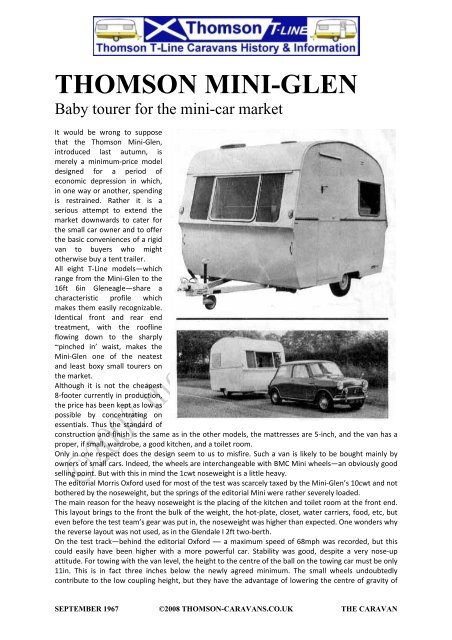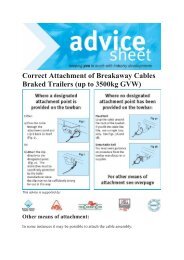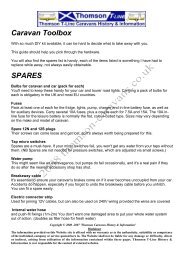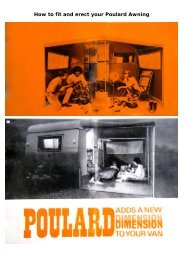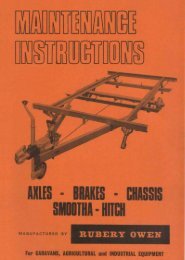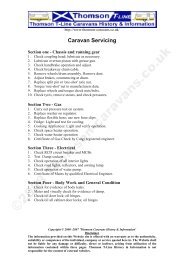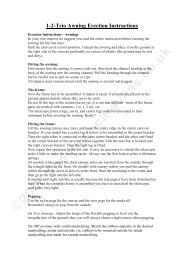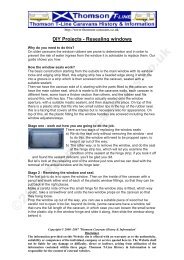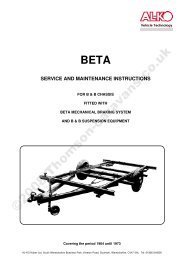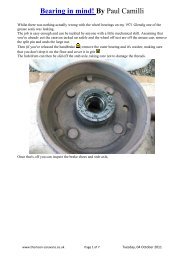You also want an ePaper? Increase the reach of your titles
YUMPU automatically turns print PDFs into web optimized ePapers that Google loves.
the van. This is particularly advantageous when towing with a light car, as the weight to weight ratios arenot likely to be very favourable. A tendency to bounce slightly on rough patches of road and to rock whenentered with the legs up was traced to the absence of shock absorbers. It is a pity that an economy suchas this is so common in small touring caravans.View through behind the editorial Oxford was one of the best we have experienced, but the driver of asmaller car would not be as lucky; with the Mini there is no view through at all. The handbrake heldperfectly on a slope of 1 in 4, and the spring‐controlled overrun brakes contributed 10 per cent of G in anemergency stop. With the brakes locked out, the outfit stopped in a straight line.As the Mini‐Glen is specially designed for towing with the BMC Mini, we put the test van behind theeditorial Mini (standard 848cc, pre‐hydrolastic model) to check its suitability as an outfit. Even behind thiscar the Mini‐Glen rode very slightly nose up (no adaptor plate) but stability wise it was excellent apartfrom noticeable pitching. Behind the more modern Hydrolastic cars this would be very noticeable andonly re‐affirms our earlier statement that the nose‐weight needs reducing.On normal main roads the outfit could cruise comfortably at around 45mph in top gear, but attempts tomaintain a consistentlyhigher cruising speednecessitated constant use ofthe gearbox and long periodsin third gear. The Mini andMini‐Glen are a perfectlysuitable combination for allnormal touring but not onethat trans‐Continental roadburners will find particularlyrewarding.The simple two‐berth layoutis both effective and neat.Basically, it comprises a rearenddouble dinette and frontendkitchen. The wardrobeand toilet room are on theoffside and there is a smallchest of drawers next to thedoor on the nearside. There isa surprising amount of floorspace, and the crampedfeeling so often present insmall vans is almost entirelyavoided. This is mainlyattributable to the generallight colouring of thefurniture and side walls, andto the white panelling of theroof and end walls. Fittedcarpeting, not usual in thestandard specification of an8‐footer, is an additionalfeature of the Mini‐Glenwhich contributes to the ‘bigvan’ feeling.The dinette converts into adouble bed in the usual waywith the table making up theSEPTEMBER <strong>1967</strong> ©2008 THOMSON-CARAVANS.CO.UK THE CARAVAN
ase of the centre section. As a bed, the size is adequate. There is a full 6ft length, but only 3ft 9in width.We found the Sin plastic foam mattresses rather too hard for real comfort. As mattress comfort is purelya matter of personal taste, manufacturers cannot be expected to please everyone. The same problem ofpersonal taste applies to the colour and patterns of the mattress covers and curtains rather more than tothe colours of the walls and furniture, which of necessity must be light and fairly neutral. In the Mini‐Glen, <strong>Thomson</strong>’s have taken a step which most manufacturers are frightened of and have made themattress covers and curtains out of a very bold and highly coloured tartan cloth. The effect is striking andwas appreciated by the test crew. The curtains, over all windows including the obscured‐glass window ofthe toilet room, are carried on plastic covered wire strainers. This method of hanging is never veryefficient. The material does not slide easily, and it is virtually impossible to open the curtains sufficiently.Overlapping wires enabled them to be closed completely. The sloping T‐I.ine profile of the end wallsnecessitates the end curtains being held against the windows by wire strainers. This is unattractive but itwould be far more annoying to have the curtains hanging loose away from the windows.The bedding lockers under each side of the dinette are top‐access, with lids hinged sufficiently far fromthe wall to allow them to be opened without completely removing the mattress. However it is difficult toget bulky items into the lockers as the lids do not extend the full length of the lockers. The lids arechipboard and would probably be strong enough to extend further. Ventilation is to the inside of the vanvia a top vent at the rear.Storage for personal items comprises a small shelved cupboard, two roof lockers, wardrobe and agenerous length of roof shelving. The shelved cupboard between the dinette and the door, serves as auseful retainer for the mattresses and as a small permanent table. In such a small van, space is greatlyrestricted if the table is left up all day. This small locker provides a place where odd items can be leftwithout the table being needed. There is a single shelf in the locker, but the floor is obstructed by thewheel arch. The shelf is set l2in from the top of the locker, and so quite large items can be accommodated.The table, which has a neutral‐coloured melamine covering, is rigid in use. The single leg cannot be fixedin the down position, and there is a danger that the table could be upset if the leg were accidentallykicked. When stowed, the leg can be clipped in the folded position.There is a roof locker above each side window. The fall‐front doors are not stayed, but there is no strainon the hinges if they are allowed to drop right down. The catches worked very well, and neither lockercame open on tow even after some fairly rough rides. A large expanse of roof locker adds considerably tooverall weight and cost, so roof shelving is used as an alternative. The Mini‐Glen roof shelves run fromthe roof lockers to the rear wall. They are 8in deep, and generous lapping means that they can be usedon tow without everything falling off. There is a small pelmet shelf above each window.Additional shelving and storage space is provided in the wardrobe. There is a top shelf but clotheshanging room is greatly restricted due to the rail running from front to back, it is almost impossible to getclothes from the back of the wardrobe when it is full. The rail could be run from side to side withoutenlarging the wardrobe. The wheel arch makes a useful shelf for shoes, etc, but clothes should be keptaway from it as it is uninsulated.SEPTEMBER <strong>1967</strong> ©2008 THOMSON-CARAVANS.CO.UK THE CARAVAN
The front‐end toilet room is used for storing the table when on tow and, as in most small tourers, allheavy items such as water carriers seem to find their way into it. The table is clipped to the wall by meansof a wooden turnbuckle. Because of the cutaway corners the table has to be clipped in upside down. Apermanent floor vent and a roof vent provide ample ventilation. Light at night is borrowed from the restof the van via a frosted glass panel in the toilet room door. The curtain pelmet and window sill are theonly shelves, but they are deep enough to accommodate many of the small items which can find nopermanent home.For the size of van, no cook could complain of lack of room in the kitchen. The hotplate and sink unit haveseparate melamine‐faced hinged working tops, and with a certain amount of organisation meals can beeasily prepared. The large front window, with a centre opening section, provides ample light for daytimecooking, but with the only gas light at the rear of the van, at night the cook stands in his own light.Curtains in the kitchen always present a problem, as they must be adequately protected from thehotplate to prevent any risk of fire. In the Mini‐Glen, the hotplate working top hinges back against thecurtain and is fastened to the wall. The working top over the sink unit rests against the frame of thecentre section of the window. There is no positive clip to hold it back, and there is a danger that with thewindow open the wind might catch it and blow it shut.Storage for food, pots and pans comprises a large unshelved cupboard with permanent floor vent underthe hotplate, and a shelved cupboard under the sink. A small top shelf is provided under the drainer,suitable for cutlery and other small items. There are no cutlery or plate racks, and no water pump. Thecupboard under the sink is obstructed by the rubber waste pipe, which at first glance seems ridiculouslylong, if it is fully extended, the end easily reaches the road. The reason for the apparently excessivelength became obvious to the test team when we tried to get a bucket under the van for the wastewater. The chassis and bodyline are so low that the only place to put the bucket is at the side of the van,hence the length of hose. It is a nuisance to have to pull the hose up through the floor when leaving site,especially as it means repacking the cupboard to accommodate it, but if it is left out, the road soon wearsdown the end.Ventilation in the kitchen is notgood if the weather demands thatboth the window and the door beclosed. The only escape forcooking fumes is through the rooflight in the centre of the roof. Adoor adjacent to the hotplate cansometimes be a nuisance asdraughts tend to upset thedirection of the gas jets and blowmost of the heat away from thehotplate. If the bottom half of thestable door of the Mini‐Glen iskept closed when cooking, thehotplate is kept reasonably freefrom draughts.The only source of artificial light isa No 1 Morco unit above thedinette. This provides excellentlight over that end of the van atthe expense of enough light in thekitchen. The piping to the lightruns between the roof and theinner panelling, and is only accessibleif the panelling is removed—a costly and time‐consuming job.The cylinder connection is outsideSEPTEMBER <strong>1967</strong> ©2008 THOMSON-CARAVANS.CO.UK THE CARAVAN
next to the drawbar. When thechassis was sprayed, the brassunion was also sprayed. Connectingand disconnecting thecylinder resulted in some of thepaint chipping away from theunion and disappearing up thepipe. In time this may easilyresult in the gas taps becomingjammed, and leaks developing.Masking while spraying thechassis would lessen thispossibility.The standard of workmanshipand finish in the interior is high.Piano hinges on most of theinside doors not only mean extrastrength in the units, but areconsiderably more attractivethan individual hinges. It ispleasant also to come acrossdoor and cupboard catcheswhich work positively and easily,and are in no danger of jumpingopen on tow.With the Mini‐Glen, <strong>Thomson</strong>’shave produced a good‐lookingand eminently workable van. Fora van with a body length of 8ft6in, the amount of room inside isremarkably good. A specificationnot cut to the bone and a goodstandard of workmanship haveinevitably led to rather a highprice for an 8‐footer, but as with any consumer goods, quality has to be paid for. It may well be that themarket for this van will extend to the larger car man, and to this end it is a pity that the drawbar is so lowthat considerable adjustment is likely to be needed before getting a really satisfactory towing height.SEPTEMBER <strong>1967</strong> ©2008 THOMSON-CARAVANS.CO.UK THE CARAVAN


